Research Proposal: Improving Customer Experience at Hahndorf Village
VerifiedAdded on 2022/08/25
|10
|2268
|16
Report
AI Summary
This research proposal aims to enhance the customer experience at Hahndorf Village, a popular tourist destination in South Australia. It begins by analyzing the business problem of increasing customer influx and shopping opportunities. The research employs a positivism philosophy and a deductive approach, using a descriptive design with a survey methodology to collect quantitative data. The proposal outlines key variables such as customer expectations, changes needed, and potential challenges, with customer influx and satisfaction as the dependent variable. Probability sampling will be used to select 100 customers randomly. Ethical considerations, including confidentiality and informed consent, are addressed to ensure data integrity and protect participants. The proposal concludes with an overview of data analysis using regression analysis to determine the impact of identified variables on customer influx. This research provides a detailed plan for investigating the factors influencing shopping enjoyment and customer satisfaction to improve the village.
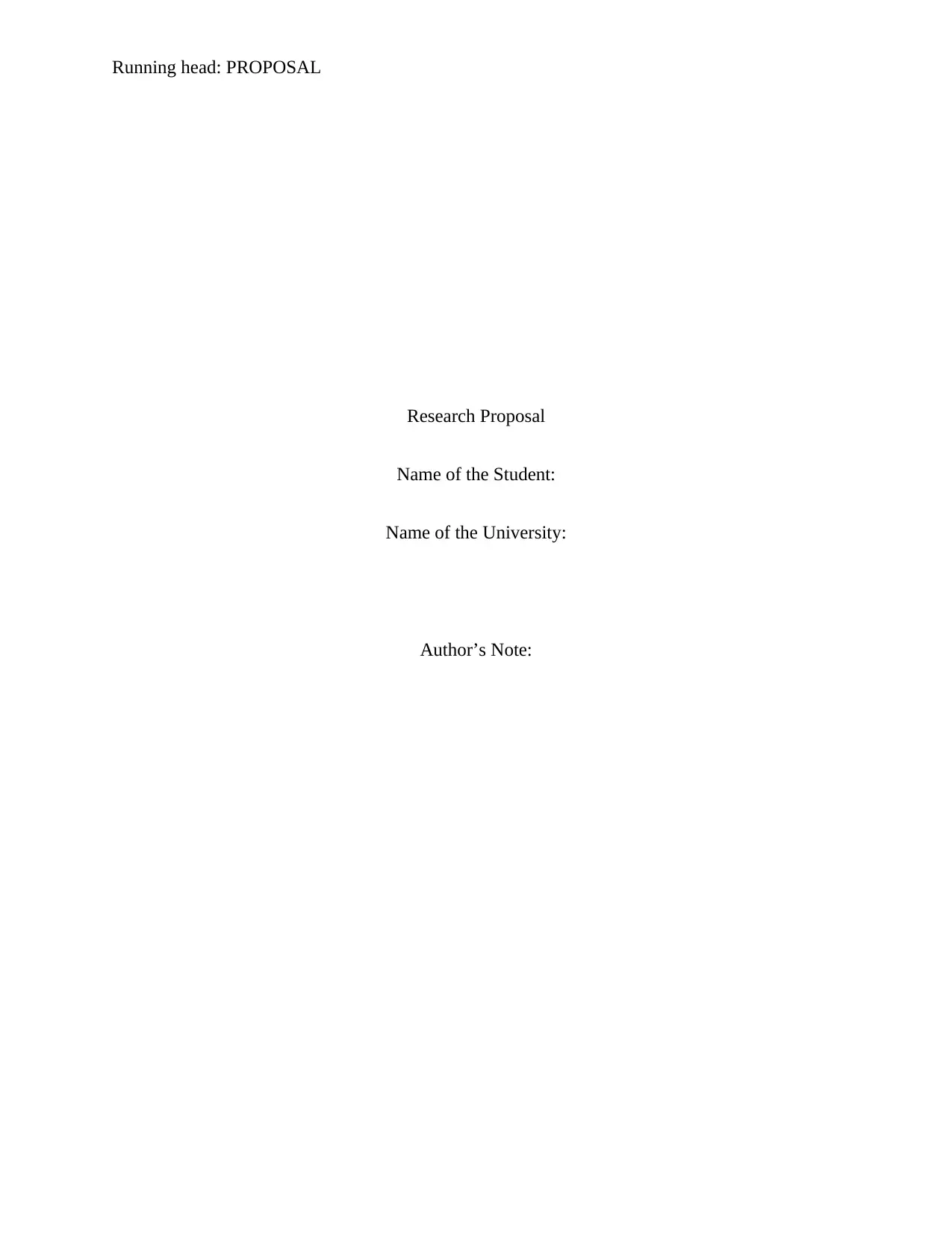
Running head: PROPOSAL
Research Proposal
Name of the Student:
Name of the University:
Author’s Note:
Research Proposal
Name of the Student:
Name of the University:
Author’s Note:
Paraphrase This Document
Need a fresh take? Get an instant paraphrase of this document with our AI Paraphraser
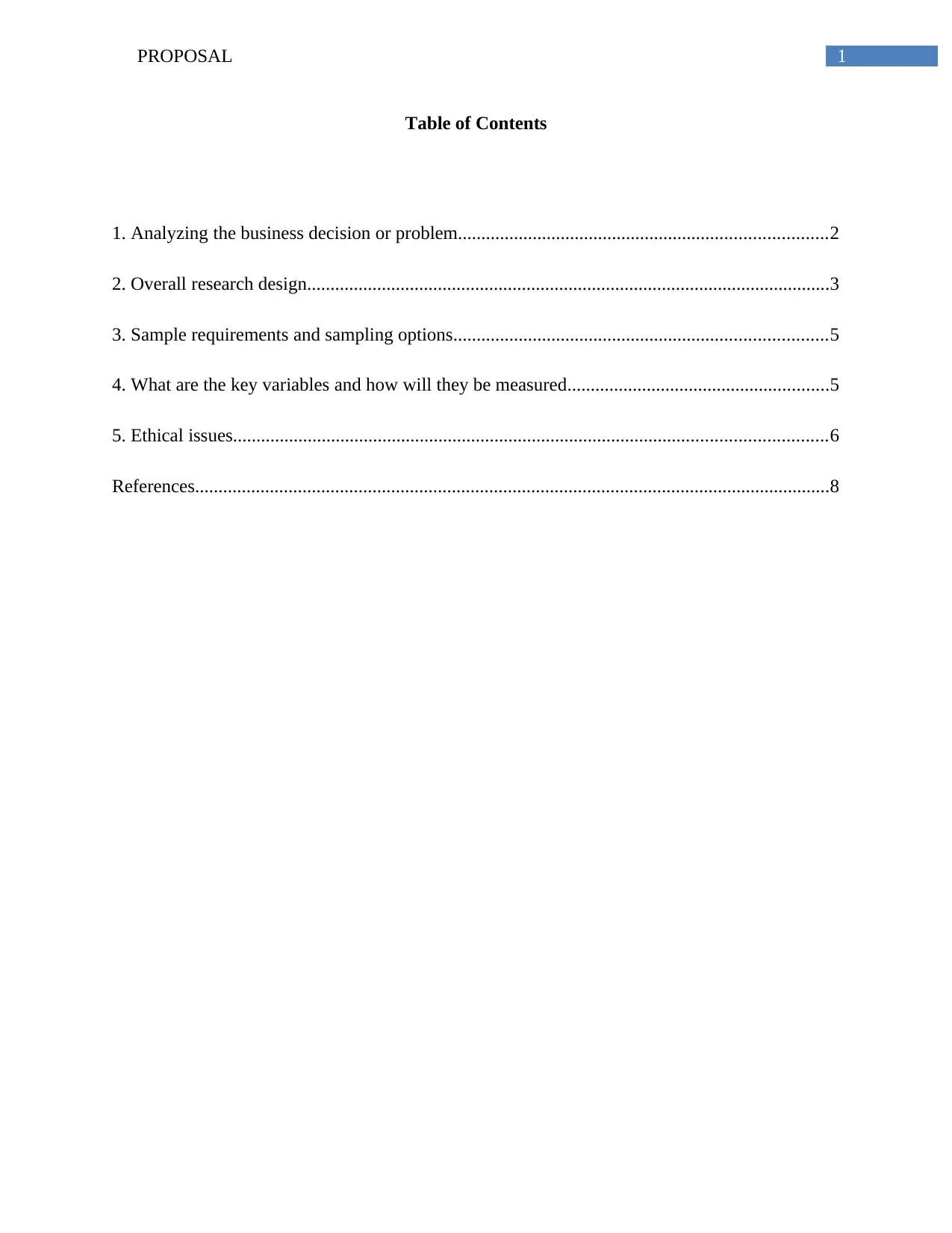
1PROPOSAL
Table of Contents
1. Analyzing the business decision or problem...............................................................................2
2. Overall research design................................................................................................................3
3. Sample requirements and sampling options................................................................................5
4. What are the key variables and how will they be measured........................................................5
5. Ethical issues...............................................................................................................................6
References........................................................................................................................................8
Table of Contents
1. Analyzing the business decision or problem...............................................................................2
2. Overall research design................................................................................................................3
3. Sample requirements and sampling options................................................................................5
4. What are the key variables and how will they be measured........................................................5
5. Ethical issues...............................................................................................................................6
References........................................................................................................................................8
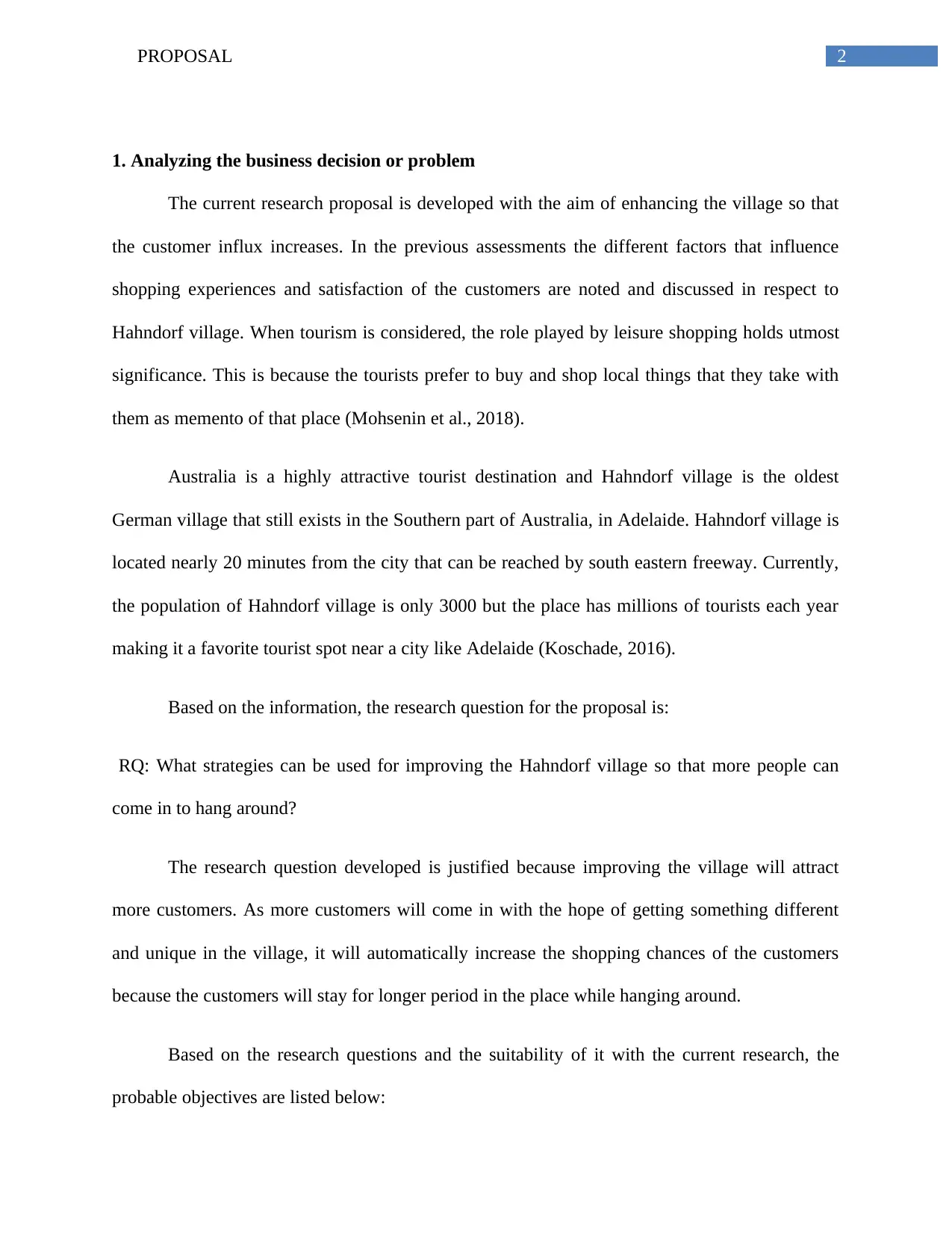
2PROPOSAL
1. Analyzing the business decision or problem
The current research proposal is developed with the aim of enhancing the village so that
the customer influx increases. In the previous assessments the different factors that influence
shopping experiences and satisfaction of the customers are noted and discussed in respect to
Hahndorf village. When tourism is considered, the role played by leisure shopping holds utmost
significance. This is because the tourists prefer to buy and shop local things that they take with
them as memento of that place (Mohsenin et al., 2018).
Australia is a highly attractive tourist destination and Hahndorf village is the oldest
German village that still exists in the Southern part of Australia, in Adelaide. Hahndorf village is
located nearly 20 minutes from the city that can be reached by south eastern freeway. Currently,
the population of Hahndorf village is only 3000 but the place has millions of tourists each year
making it a favorite tourist spot near a city like Adelaide (Koschade, 2016).
Based on the information, the research question for the proposal is:
RQ: What strategies can be used for improving the Hahndorf village so that more people can
come in to hang around?
The research question developed is justified because improving the village will attract
more customers. As more customers will come in with the hope of getting something different
and unique in the village, it will automatically increase the shopping chances of the customers
because the customers will stay for longer period in the place while hanging around.
Based on the research questions and the suitability of it with the current research, the
probable objectives are listed below:
1. Analyzing the business decision or problem
The current research proposal is developed with the aim of enhancing the village so that
the customer influx increases. In the previous assessments the different factors that influence
shopping experiences and satisfaction of the customers are noted and discussed in respect to
Hahndorf village. When tourism is considered, the role played by leisure shopping holds utmost
significance. This is because the tourists prefer to buy and shop local things that they take with
them as memento of that place (Mohsenin et al., 2018).
Australia is a highly attractive tourist destination and Hahndorf village is the oldest
German village that still exists in the Southern part of Australia, in Adelaide. Hahndorf village is
located nearly 20 minutes from the city that can be reached by south eastern freeway. Currently,
the population of Hahndorf village is only 3000 but the place has millions of tourists each year
making it a favorite tourist spot near a city like Adelaide (Koschade, 2016).
Based on the information, the research question for the proposal is:
RQ: What strategies can be used for improving the Hahndorf village so that more people can
come in to hang around?
The research question developed is justified because improving the village will attract
more customers. As more customers will come in with the hope of getting something different
and unique in the village, it will automatically increase the shopping chances of the customers
because the customers will stay for longer period in the place while hanging around.
Based on the research questions and the suitability of it with the current research, the
probable objectives are listed below:
⊘ This is a preview!⊘
Do you want full access?
Subscribe today to unlock all pages.

Trusted by 1+ million students worldwide
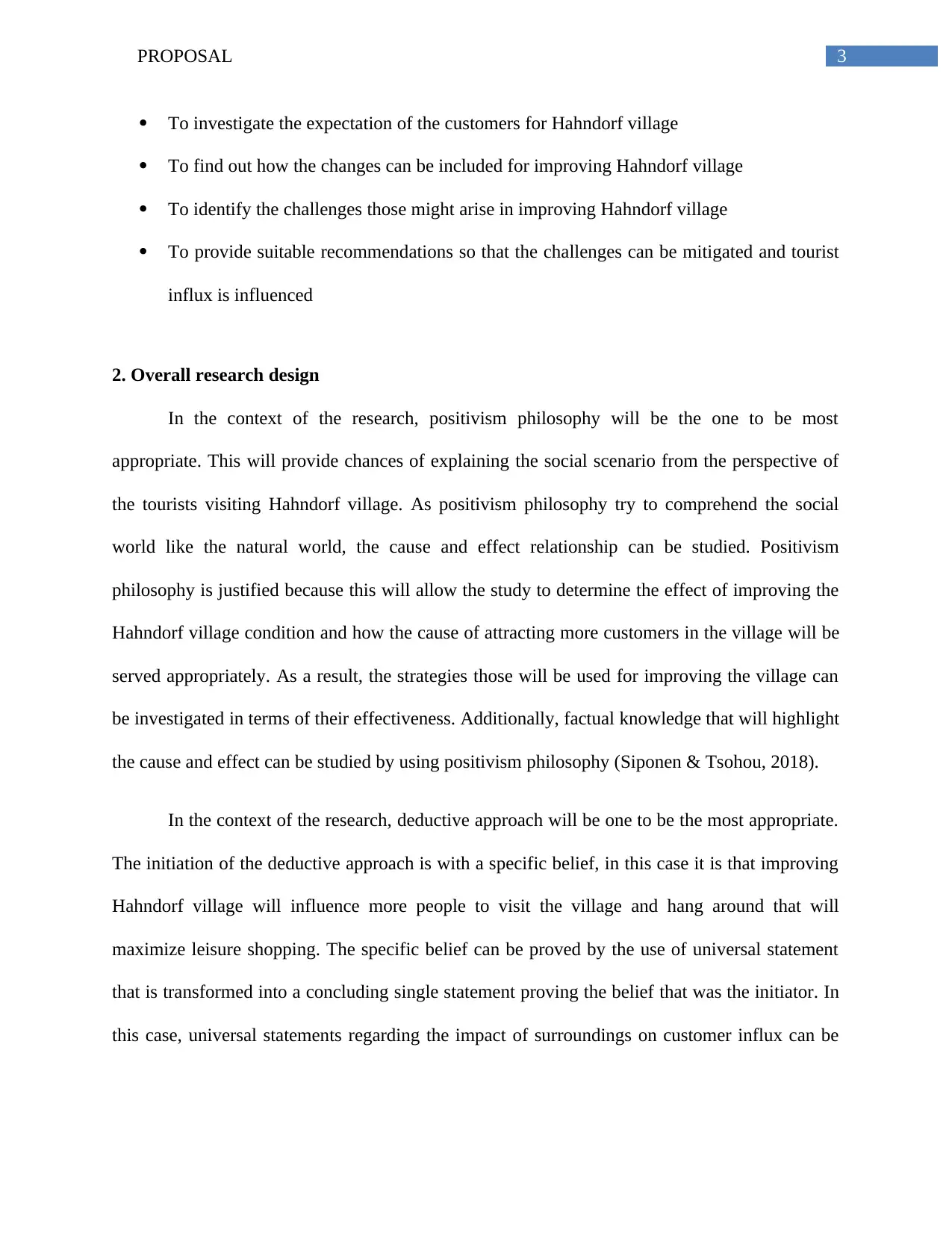
3PROPOSAL
To investigate the expectation of the customers for Hahndorf village
To find out how the changes can be included for improving Hahndorf village
To identify the challenges those might arise in improving Hahndorf village
To provide suitable recommendations so that the challenges can be mitigated and tourist
influx is influenced
2. Overall research design
In the context of the research, positivism philosophy will be the one to be most
appropriate. This will provide chances of explaining the social scenario from the perspective of
the tourists visiting Hahndorf village. As positivism philosophy try to comprehend the social
world like the natural world, the cause and effect relationship can be studied. Positivism
philosophy is justified because this will allow the study to determine the effect of improving the
Hahndorf village condition and how the cause of attracting more customers in the village will be
served appropriately. As a result, the strategies those will be used for improving the village can
be investigated in terms of their effectiveness. Additionally, factual knowledge that will highlight
the cause and effect can be studied by using positivism philosophy (Siponen & Tsohou, 2018).
In the context of the research, deductive approach will be one to be the most appropriate.
The initiation of the deductive approach is with a specific belief, in this case it is that improving
Hahndorf village will influence more people to visit the village and hang around that will
maximize leisure shopping. The specific belief can be proved by the use of universal statement
that is transformed into a concluding single statement proving the belief that was the initiator. In
this case, universal statements regarding the impact of surroundings on customer influx can be
To investigate the expectation of the customers for Hahndorf village
To find out how the changes can be included for improving Hahndorf village
To identify the challenges those might arise in improving Hahndorf village
To provide suitable recommendations so that the challenges can be mitigated and tourist
influx is influenced
2. Overall research design
In the context of the research, positivism philosophy will be the one to be most
appropriate. This will provide chances of explaining the social scenario from the perspective of
the tourists visiting Hahndorf village. As positivism philosophy try to comprehend the social
world like the natural world, the cause and effect relationship can be studied. Positivism
philosophy is justified because this will allow the study to determine the effect of improving the
Hahndorf village condition and how the cause of attracting more customers in the village will be
served appropriately. As a result, the strategies those will be used for improving the village can
be investigated in terms of their effectiveness. Additionally, factual knowledge that will highlight
the cause and effect can be studied by using positivism philosophy (Siponen & Tsohou, 2018).
In the context of the research, deductive approach will be one to be the most appropriate.
The initiation of the deductive approach is with a specific belief, in this case it is that improving
Hahndorf village will influence more people to visit the village and hang around that will
maximize leisure shopping. The specific belief can be proved by the use of universal statement
that is transformed into a concluding single statement proving the belief that was the initiator. In
this case, universal statements regarding the impact of surroundings on customer influx can be
Paraphrase This Document
Need a fresh take? Get an instant paraphrase of this document with our AI Paraphraser
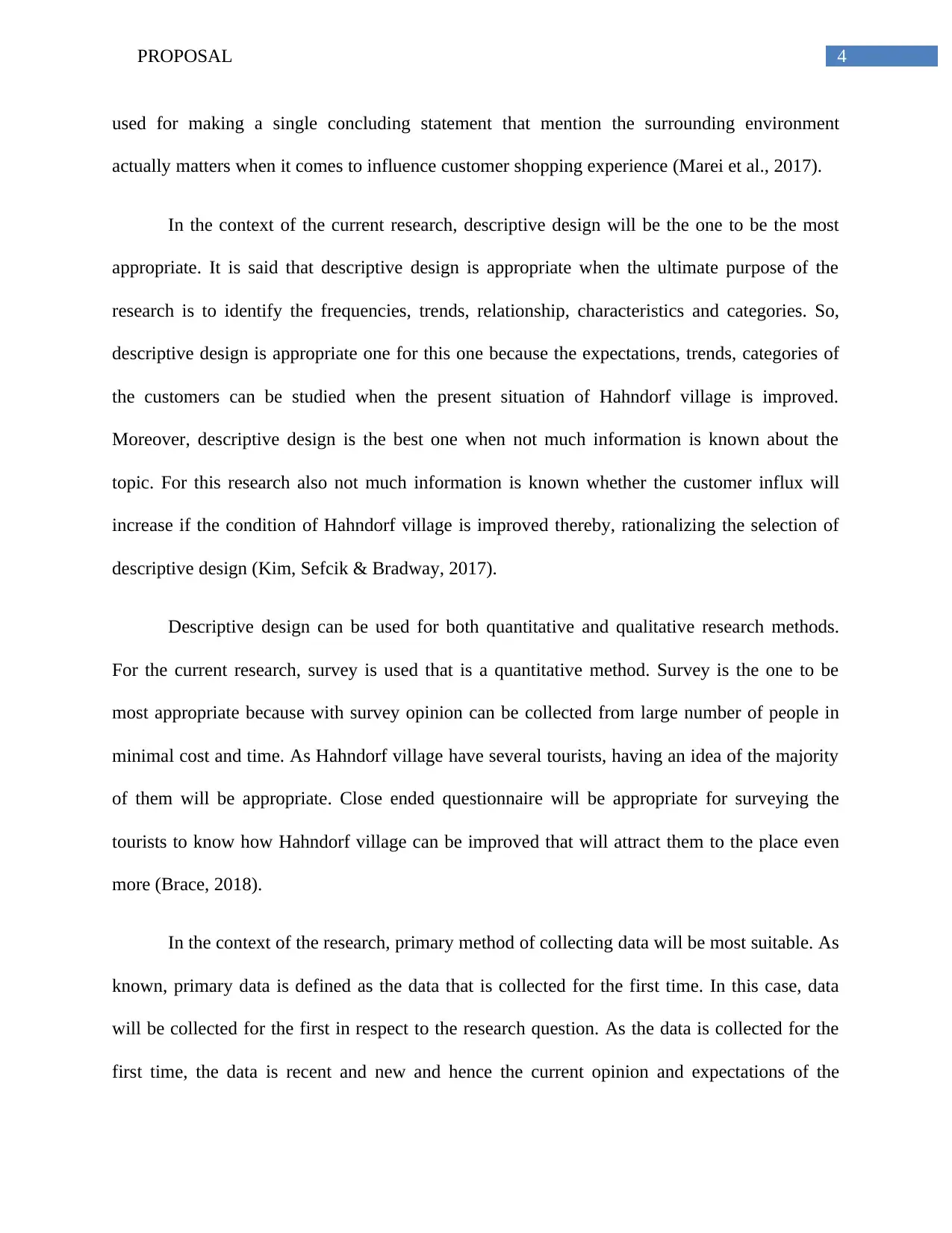
4PROPOSAL
used for making a single concluding statement that mention the surrounding environment
actually matters when it comes to influence customer shopping experience (Marei et al., 2017).
In the context of the current research, descriptive design will be the one to be the most
appropriate. It is said that descriptive design is appropriate when the ultimate purpose of the
research is to identify the frequencies, trends, relationship, characteristics and categories. So,
descriptive design is appropriate one for this one because the expectations, trends, categories of
the customers can be studied when the present situation of Hahndorf village is improved.
Moreover, descriptive design is the best one when not much information is known about the
topic. For this research also not much information is known whether the customer influx will
increase if the condition of Hahndorf village is improved thereby, rationalizing the selection of
descriptive design (Kim, Sefcik & Bradway, 2017).
Descriptive design can be used for both quantitative and qualitative research methods.
For the current research, survey is used that is a quantitative method. Survey is the one to be
most appropriate because with survey opinion can be collected from large number of people in
minimal cost and time. As Hahndorf village have several tourists, having an idea of the majority
of them will be appropriate. Close ended questionnaire will be appropriate for surveying the
tourists to know how Hahndorf village can be improved that will attract them to the place even
more (Brace, 2018).
In the context of the research, primary method of collecting data will be most suitable. As
known, primary data is defined as the data that is collected for the first time. In this case, data
will be collected for the first in respect to the research question. As the data is collected for the
first time, the data is recent and new and hence the current opinion and expectations of the
used for making a single concluding statement that mention the surrounding environment
actually matters when it comes to influence customer shopping experience (Marei et al., 2017).
In the context of the current research, descriptive design will be the one to be the most
appropriate. It is said that descriptive design is appropriate when the ultimate purpose of the
research is to identify the frequencies, trends, relationship, characteristics and categories. So,
descriptive design is appropriate one for this one because the expectations, trends, categories of
the customers can be studied when the present situation of Hahndorf village is improved.
Moreover, descriptive design is the best one when not much information is known about the
topic. For this research also not much information is known whether the customer influx will
increase if the condition of Hahndorf village is improved thereby, rationalizing the selection of
descriptive design (Kim, Sefcik & Bradway, 2017).
Descriptive design can be used for both quantitative and qualitative research methods.
For the current research, survey is used that is a quantitative method. Survey is the one to be
most appropriate because with survey opinion can be collected from large number of people in
minimal cost and time. As Hahndorf village have several tourists, having an idea of the majority
of them will be appropriate. Close ended questionnaire will be appropriate for surveying the
tourists to know how Hahndorf village can be improved that will attract them to the place even
more (Brace, 2018).
In the context of the research, primary method of collecting data will be most suitable. As
known, primary data is defined as the data that is collected for the first time. In this case, data
will be collected for the first in respect to the research question. As the data is collected for the
first time, the data is recent and new and hence the current opinion and expectations of the
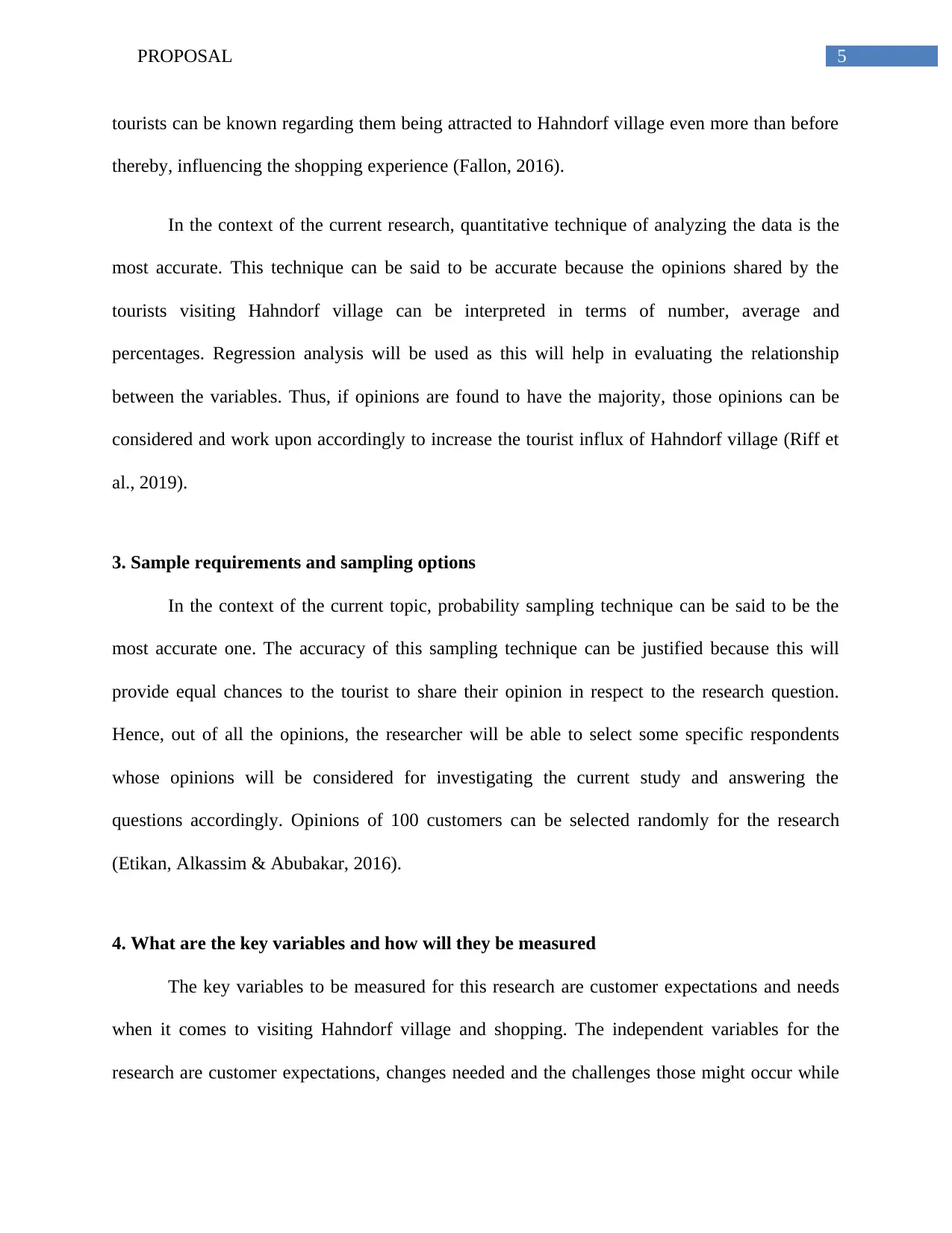
5PROPOSAL
tourists can be known regarding them being attracted to Hahndorf village even more than before
thereby, influencing the shopping experience (Fallon, 2016).
In the context of the current research, quantitative technique of analyzing the data is the
most accurate. This technique can be said to be accurate because the opinions shared by the
tourists visiting Hahndorf village can be interpreted in terms of number, average and
percentages. Regression analysis will be used as this will help in evaluating the relationship
between the variables. Thus, if opinions are found to have the majority, those opinions can be
considered and work upon accordingly to increase the tourist influx of Hahndorf village (Riff et
al., 2019).
3. Sample requirements and sampling options
In the context of the current topic, probability sampling technique can be said to be the
most accurate one. The accuracy of this sampling technique can be justified because this will
provide equal chances to the tourist to share their opinion in respect to the research question.
Hence, out of all the opinions, the researcher will be able to select some specific respondents
whose opinions will be considered for investigating the current study and answering the
questions accordingly. Opinions of 100 customers can be selected randomly for the research
(Etikan, Alkassim & Abubakar, 2016).
4. What are the key variables and how will they be measured
The key variables to be measured for this research are customer expectations and needs
when it comes to visiting Hahndorf village and shopping. The independent variables for the
research are customer expectations, changes needed and the challenges those might occur while
tourists can be known regarding them being attracted to Hahndorf village even more than before
thereby, influencing the shopping experience (Fallon, 2016).
In the context of the current research, quantitative technique of analyzing the data is the
most accurate. This technique can be said to be accurate because the opinions shared by the
tourists visiting Hahndorf village can be interpreted in terms of number, average and
percentages. Regression analysis will be used as this will help in evaluating the relationship
between the variables. Thus, if opinions are found to have the majority, those opinions can be
considered and work upon accordingly to increase the tourist influx of Hahndorf village (Riff et
al., 2019).
3. Sample requirements and sampling options
In the context of the current topic, probability sampling technique can be said to be the
most accurate one. The accuracy of this sampling technique can be justified because this will
provide equal chances to the tourist to share their opinion in respect to the research question.
Hence, out of all the opinions, the researcher will be able to select some specific respondents
whose opinions will be considered for investigating the current study and answering the
questions accordingly. Opinions of 100 customers can be selected randomly for the research
(Etikan, Alkassim & Abubakar, 2016).
4. What are the key variables and how will they be measured
The key variables to be measured for this research are customer expectations and needs
when it comes to visiting Hahndorf village and shopping. The independent variables for the
research are customer expectations, changes needed and the challenges those might occur while
⊘ This is a preview!⊘
Do you want full access?
Subscribe today to unlock all pages.

Trusted by 1+ million students worldwide
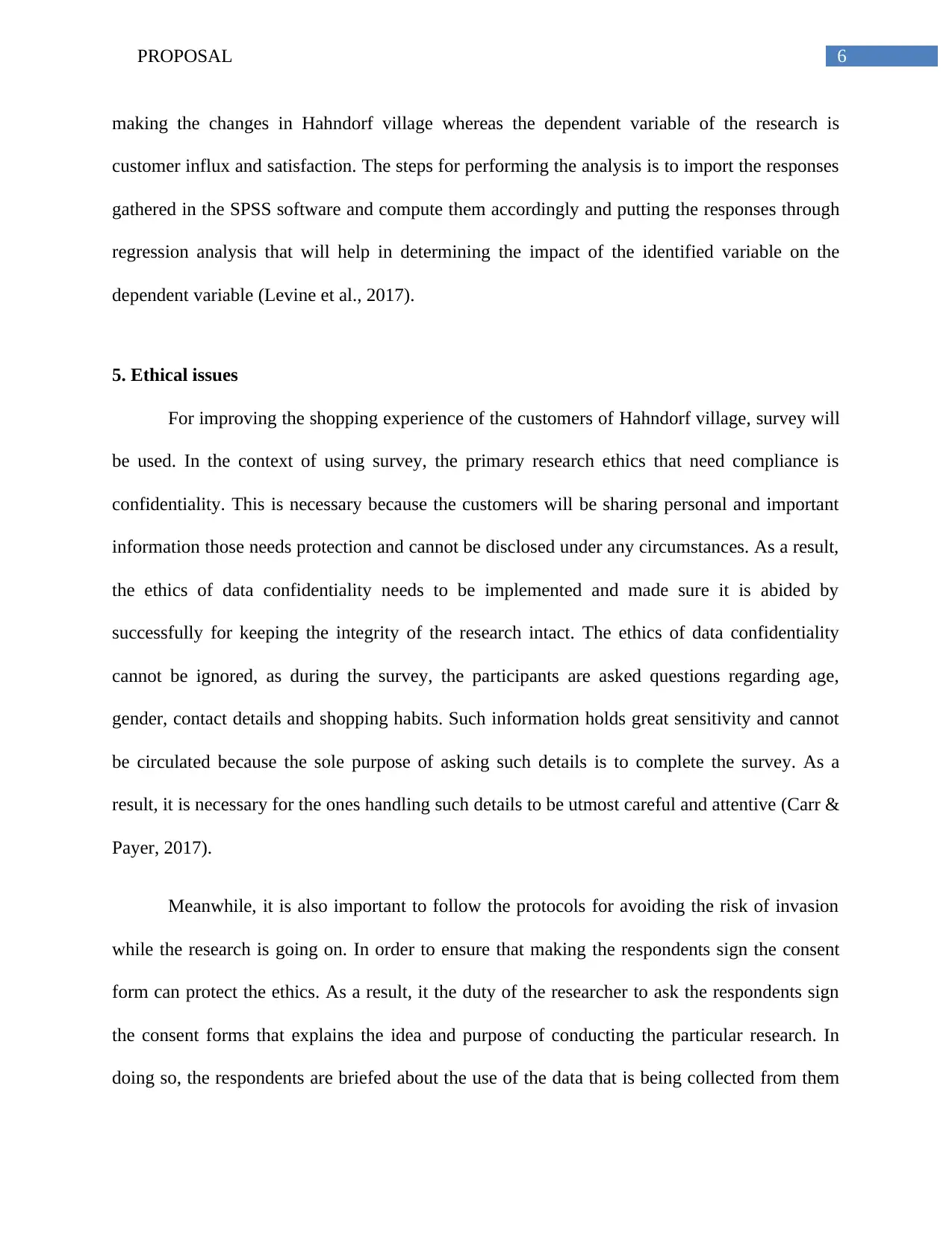
6PROPOSAL
making the changes in Hahndorf village whereas the dependent variable of the research is
customer influx and satisfaction. The steps for performing the analysis is to import the responses
gathered in the SPSS software and compute them accordingly and putting the responses through
regression analysis that will help in determining the impact of the identified variable on the
dependent variable (Levine et al., 2017).
5. Ethical issues
For improving the shopping experience of the customers of Hahndorf village, survey will
be used. In the context of using survey, the primary research ethics that need compliance is
confidentiality. This is necessary because the customers will be sharing personal and important
information those needs protection and cannot be disclosed under any circumstances. As a result,
the ethics of data confidentiality needs to be implemented and made sure it is abided by
successfully for keeping the integrity of the research intact. The ethics of data confidentiality
cannot be ignored, as during the survey, the participants are asked questions regarding age,
gender, contact details and shopping habits. Such information holds great sensitivity and cannot
be circulated because the sole purpose of asking such details is to complete the survey. As a
result, it is necessary for the ones handling such details to be utmost careful and attentive (Carr &
Payer, 2017).
Meanwhile, it is also important to follow the protocols for avoiding the risk of invasion
while the research is going on. In order to ensure that making the respondents sign the consent
form can protect the ethics. As a result, it the duty of the researcher to ask the respondents sign
the consent forms that explains the idea and purpose of conducting the particular research. In
doing so, the respondents are briefed about the use of the data that is being collected from them
making the changes in Hahndorf village whereas the dependent variable of the research is
customer influx and satisfaction. The steps for performing the analysis is to import the responses
gathered in the SPSS software and compute them accordingly and putting the responses through
regression analysis that will help in determining the impact of the identified variable on the
dependent variable (Levine et al., 2017).
5. Ethical issues
For improving the shopping experience of the customers of Hahndorf village, survey will
be used. In the context of using survey, the primary research ethics that need compliance is
confidentiality. This is necessary because the customers will be sharing personal and important
information those needs protection and cannot be disclosed under any circumstances. As a result,
the ethics of data confidentiality needs to be implemented and made sure it is abided by
successfully for keeping the integrity of the research intact. The ethics of data confidentiality
cannot be ignored, as during the survey, the participants are asked questions regarding age,
gender, contact details and shopping habits. Such information holds great sensitivity and cannot
be circulated because the sole purpose of asking such details is to complete the survey. As a
result, it is necessary for the ones handling such details to be utmost careful and attentive (Carr &
Payer, 2017).
Meanwhile, it is also important to follow the protocols for avoiding the risk of invasion
while the research is going on. In order to ensure that making the respondents sign the consent
form can protect the ethics. As a result, it the duty of the researcher to ask the respondents sign
the consent forms that explains the idea and purpose of conducting the particular research. In
doing so, the respondents are briefed about the use of the data that is being collected from them
Paraphrase This Document
Need a fresh take? Get an instant paraphrase of this document with our AI Paraphraser
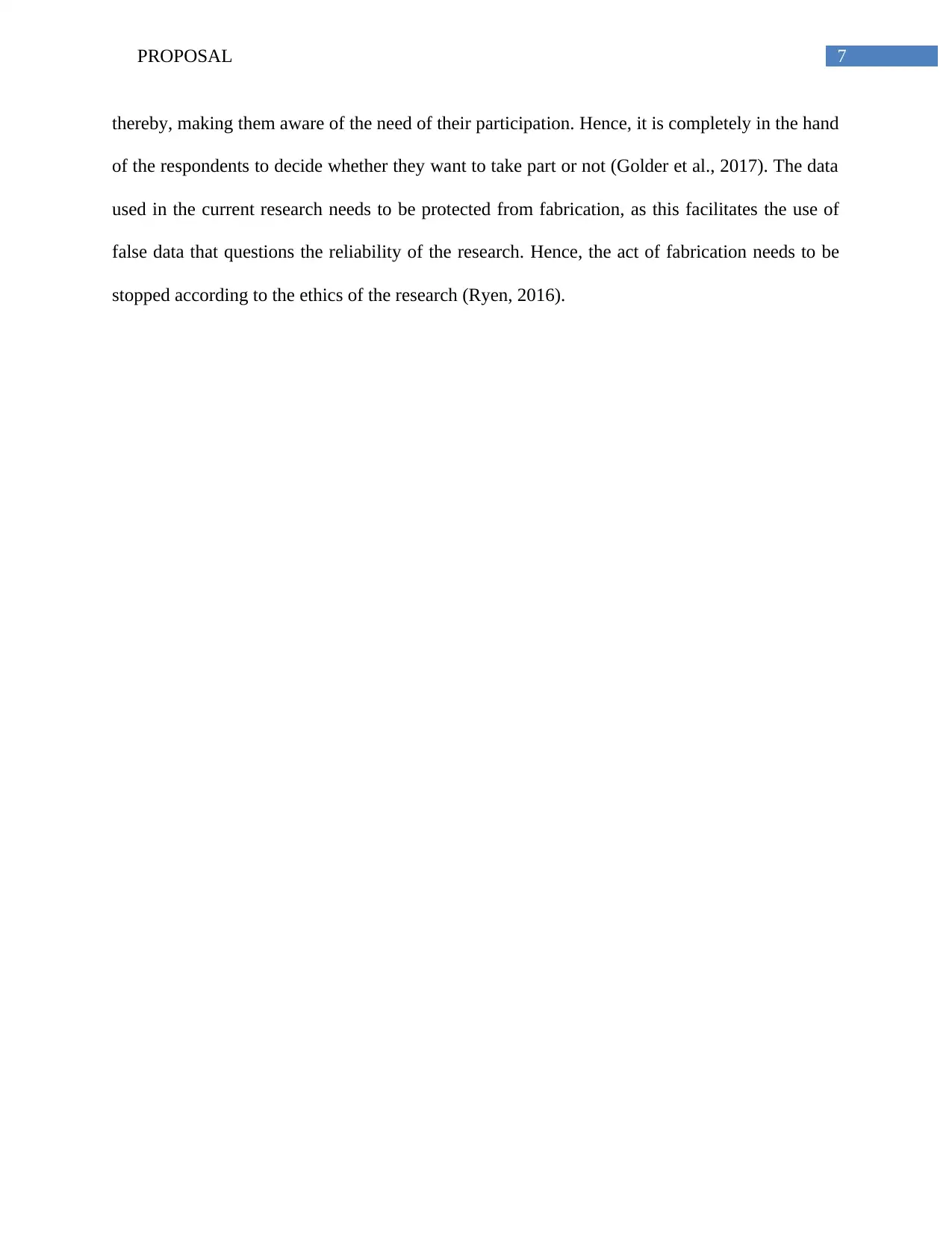
7PROPOSAL
thereby, making them aware of the need of their participation. Hence, it is completely in the hand
of the respondents to decide whether they want to take part or not (Golder et al., 2017). The data
used in the current research needs to be protected from fabrication, as this facilitates the use of
false data that questions the reliability of the research. Hence, the act of fabrication needs to be
stopped according to the ethics of the research (Ryen, 2016).
thereby, making them aware of the need of their participation. Hence, it is completely in the hand
of the respondents to decide whether they want to take part or not (Golder et al., 2017). The data
used in the current research needs to be protected from fabrication, as this facilitates the use of
false data that questions the reliability of the research. Hence, the act of fabrication needs to be
stopped according to the ethics of the research (Ryen, 2016).
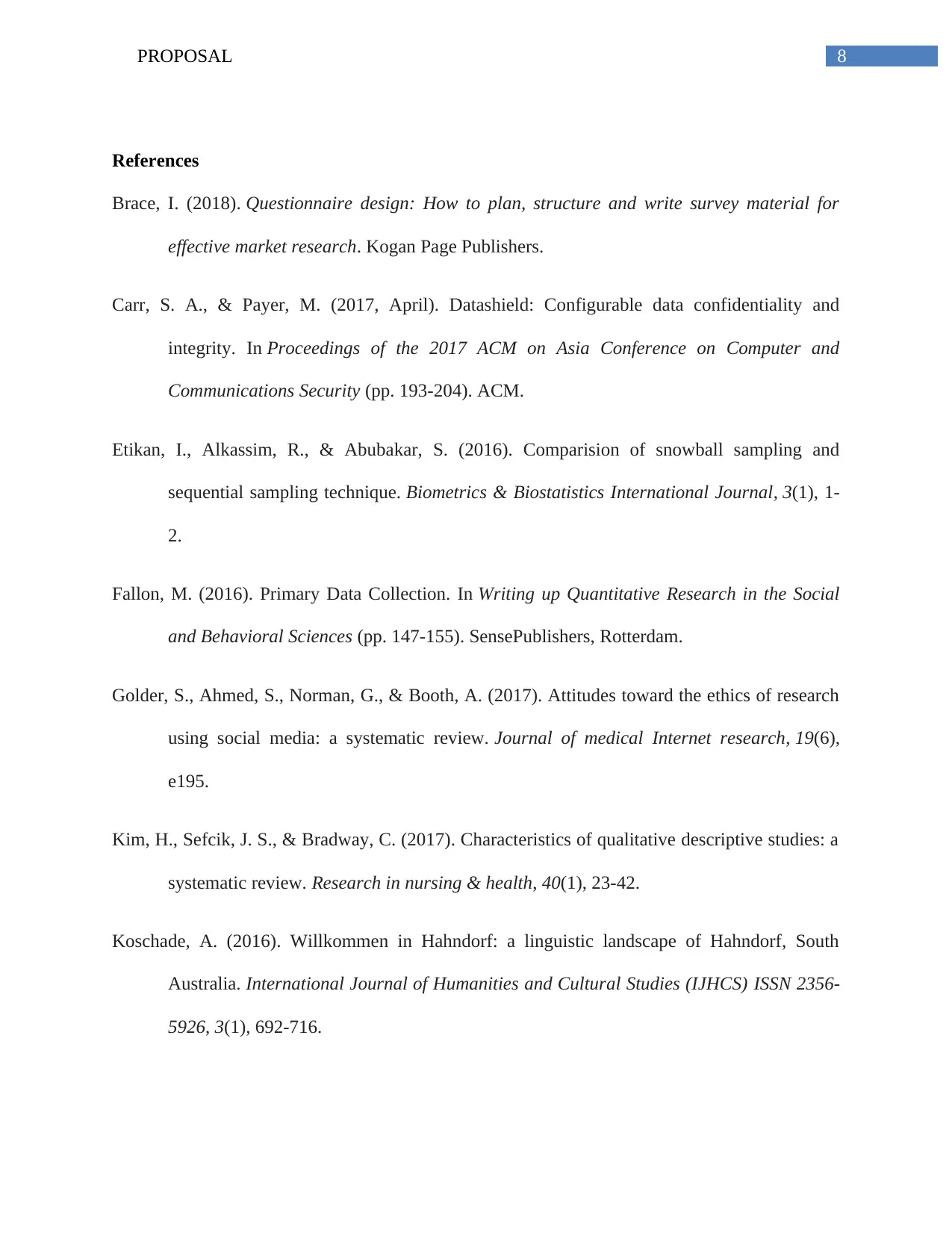
8PROPOSAL
References
Brace, I. (2018). Questionnaire design: How to plan, structure and write survey material for
effective market research. Kogan Page Publishers.
Carr, S. A., & Payer, M. (2017, April). Datashield: Configurable data confidentiality and
integrity. In Proceedings of the 2017 ACM on Asia Conference on Computer and
Communications Security (pp. 193-204). ACM.
Etikan, I., Alkassim, R., & Abubakar, S. (2016). Comparision of snowball sampling and
sequential sampling technique. Biometrics & Biostatistics International Journal, 3(1), 1-
2.
Fallon, M. (2016). Primary Data Collection. In Writing up Quantitative Research in the Social
and Behavioral Sciences (pp. 147-155). SensePublishers, Rotterdam.
Golder, S., Ahmed, S., Norman, G., & Booth, A. (2017). Attitudes toward the ethics of research
using social media: a systematic review. Journal of medical Internet research, 19(6),
e195.
Kim, H., Sefcik, J. S., & Bradway, C. (2017). Characteristics of qualitative descriptive studies: a
systematic review. Research in nursing & health, 40(1), 23-42.
Koschade, A. (2016). Willkommen in Hahndorf: a linguistic landscape of Hahndorf, South
Australia. International Journal of Humanities and Cultural Studies (IJHCS) ISSN 2356-
5926, 3(1), 692-716.
References
Brace, I. (2018). Questionnaire design: How to plan, structure and write survey material for
effective market research. Kogan Page Publishers.
Carr, S. A., & Payer, M. (2017, April). Datashield: Configurable data confidentiality and
integrity. In Proceedings of the 2017 ACM on Asia Conference on Computer and
Communications Security (pp. 193-204). ACM.
Etikan, I., Alkassim, R., & Abubakar, S. (2016). Comparision of snowball sampling and
sequential sampling technique. Biometrics & Biostatistics International Journal, 3(1), 1-
2.
Fallon, M. (2016). Primary Data Collection. In Writing up Quantitative Research in the Social
and Behavioral Sciences (pp. 147-155). SensePublishers, Rotterdam.
Golder, S., Ahmed, S., Norman, G., & Booth, A. (2017). Attitudes toward the ethics of research
using social media: a systematic review. Journal of medical Internet research, 19(6),
e195.
Kim, H., Sefcik, J. S., & Bradway, C. (2017). Characteristics of qualitative descriptive studies: a
systematic review. Research in nursing & health, 40(1), 23-42.
Koschade, A. (2016). Willkommen in Hahndorf: a linguistic landscape of Hahndorf, South
Australia. International Journal of Humanities and Cultural Studies (IJHCS) ISSN 2356-
5926, 3(1), 692-716.
⊘ This is a preview!⊘
Do you want full access?
Subscribe today to unlock all pages.

Trusted by 1+ million students worldwide
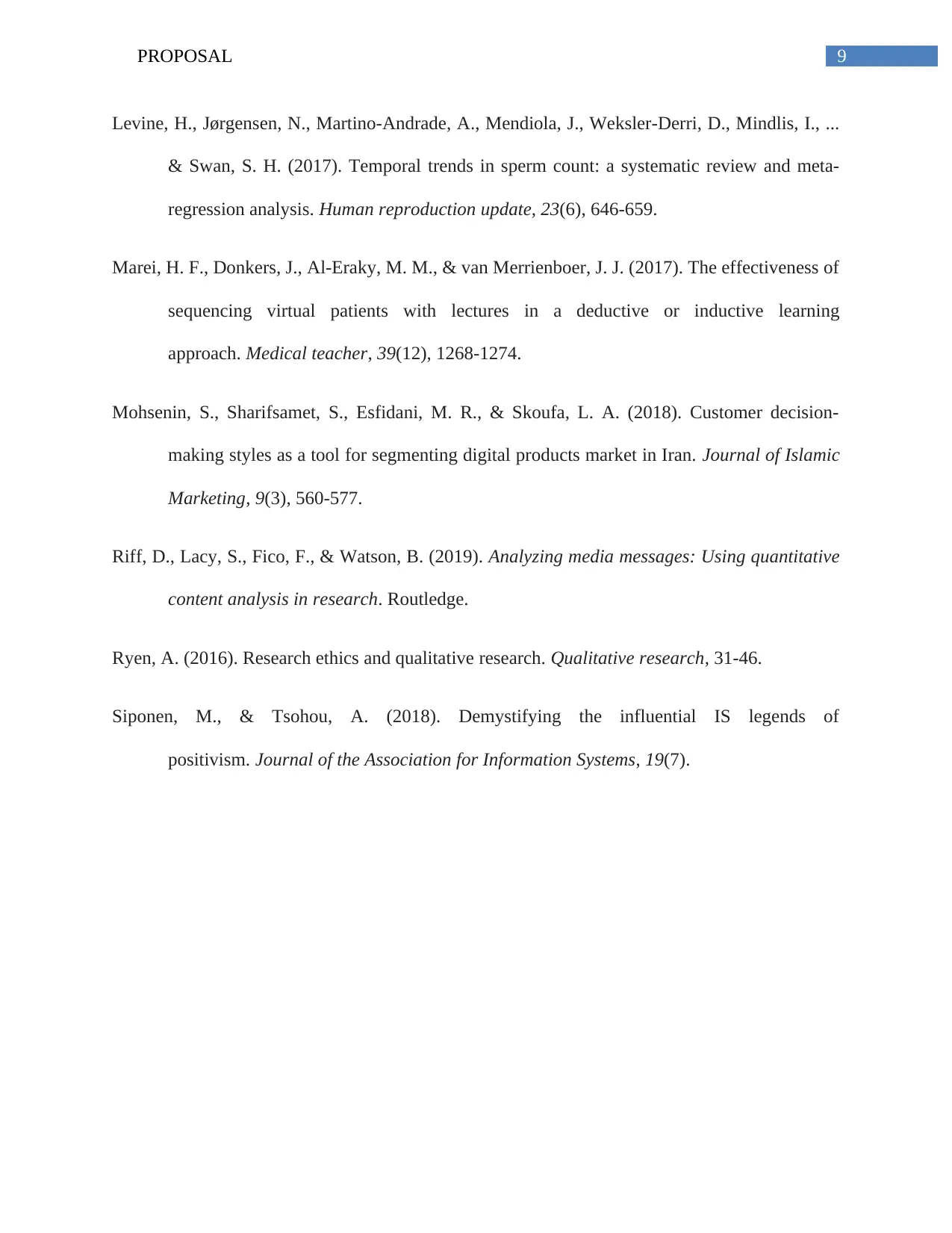
9PROPOSAL
Levine, H., Jørgensen, N., Martino-Andrade, A., Mendiola, J., Weksler-Derri, D., Mindlis, I., ...
& Swan, S. H. (2017). Temporal trends in sperm count: a systematic review and meta-
regression analysis. Human reproduction update, 23(6), 646-659.
Marei, H. F., Donkers, J., Al-Eraky, M. M., & van Merrienboer, J. J. (2017). The effectiveness of
sequencing virtual patients with lectures in a deductive or inductive learning
approach. Medical teacher, 39(12), 1268-1274.
Mohsenin, S., Sharifsamet, S., Esfidani, M. R., & Skoufa, L. A. (2018). Customer decision-
making styles as a tool for segmenting digital products market in Iran. Journal of Islamic
Marketing, 9(3), 560-577.
Riff, D., Lacy, S., Fico, F., & Watson, B. (2019). Analyzing media messages: Using quantitative
content analysis in research. Routledge.
Ryen, A. (2016). Research ethics and qualitative research. Qualitative research, 31-46.
Siponen, M., & Tsohou, A. (2018). Demystifying the influential IS legends of
positivism. Journal of the Association for Information Systems, 19(7).
Levine, H., Jørgensen, N., Martino-Andrade, A., Mendiola, J., Weksler-Derri, D., Mindlis, I., ...
& Swan, S. H. (2017). Temporal trends in sperm count: a systematic review and meta-
regression analysis. Human reproduction update, 23(6), 646-659.
Marei, H. F., Donkers, J., Al-Eraky, M. M., & van Merrienboer, J. J. (2017). The effectiveness of
sequencing virtual patients with lectures in a deductive or inductive learning
approach. Medical teacher, 39(12), 1268-1274.
Mohsenin, S., Sharifsamet, S., Esfidani, M. R., & Skoufa, L. A. (2018). Customer decision-
making styles as a tool for segmenting digital products market in Iran. Journal of Islamic
Marketing, 9(3), 560-577.
Riff, D., Lacy, S., Fico, F., & Watson, B. (2019). Analyzing media messages: Using quantitative
content analysis in research. Routledge.
Ryen, A. (2016). Research ethics and qualitative research. Qualitative research, 31-46.
Siponen, M., & Tsohou, A. (2018). Demystifying the influential IS legends of
positivism. Journal of the Association for Information Systems, 19(7).
1 out of 10
Related Documents
Your All-in-One AI-Powered Toolkit for Academic Success.
+13062052269
info@desklib.com
Available 24*7 on WhatsApp / Email
![[object Object]](/_next/static/media/star-bottom.7253800d.svg)
Unlock your academic potential
Copyright © 2020–2025 A2Z Services. All Rights Reserved. Developed and managed by ZUCOL.





